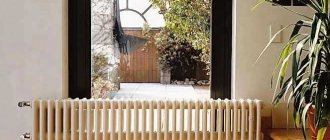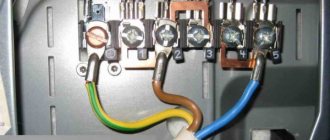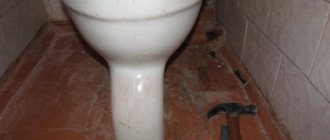Without special knowledge, you can replace a cast-iron battery with a bimetallic one in your apartment with your own hands. The service life of cast iron batteries is on average 35-40 years. In heating systems without draining water (for the summer), the period is extended to 50 years.
This means that the unreplaced Soviet fund threatens apartment owners (and downstairs neighbors) with a sudden outburst.
Experience shows that even untrained people can dismantle and install home heating appliances.
Stores offer a wide range of bimetallic batteries and accessories for installation and replacement.
Replacing cast iron batteries in a private house. Differences between cast iron and aluminum batteries
It is unlikely that the central heating network can be called a favorable environment that is suitable for any type of metal. On the contrary, the coolant in it is often not only aggressive, since it has high acidity, causing corrosion, but is also heavily littered. For this reason, some types of radiators are not recommended for installation in high-rise buildings with a central heating method.
Replacing cast iron batteries with aluminum counterparts in apartment buildings is not the best option for updating the heating system. There is a simple explanation for this, which is best conveyed by comparing the technical indicators of these two metals.
| View | Design | Connection type | Volume | Corrosion resistance | Operating pressure | Building height | Guarantee | Heat dissipation |
| cast iron | sections | lateral | old: 1.5l new: 0.8l | high | 9-12 atm. | 5 floors | 10-30 years | 110 W |
| aluminum | sections | lateral | 0.2-0.27l | low | 15-18 atm. | 5-9 floors | 10 years | 140-180 W |
The table clearly explains why aluminum radiators cannot be used instead of cast iron ones. Their low resistance to the chemical composition of water and short service life make it possible to successfully use their other qualities in autonomous heating systems.
Therefore, the question of how to replace a cast-iron battery with an aluminum model in an apartment building should not even be asked. They are not an alternative to each other. Replacing cast iron with aluminum in a private home is a great opportunity to significantly increase the heat output of a heater for little money, thereby reducing heating costs.
Installation of new radiators
If the question of whether it is worth replacing cast iron batteries with modern bimetallic devices is decided in favor of the latter, then installing them will not be difficult, even alone. The weight of these structures is quite small, so you can not only carry out the work yourself, but even use the remaining fasteners from cast iron batteries, if they are not loose.
For the installation to be successful, you need to study the product data sheet, which indicates how it should be connected to the heating system. Bimetallic sectional radiators have 4 holes, through two of them the coolant will flow in and out, and the remaining two must be closed with plugs that are included with the heater.
The sequence of actions when installing batteries is as follows:
- Depending on the size of the bimetallic heating radiator, a place under the window is determined for it; it is better if the location is in the center of the opening.
- The radiator is placed exclusively in a horizontal position, and there must be a factory protective film on it, which should not be removed until the end of the work. This will protect the product from possible external damage, such as paint chips.
The installation of a two-metal battery must be carried out taking into account the distance from the wall, floor and window sill, approved by SNiP. If these parameters are violated, the performance of even such a powerful device may be reduced.
- If it is necessary to install new brackets, then the battery must be attached to the selected location and marked with a pencil on the wall where the brackets should be.
- The brackets are fixed to the wall with dowels and cement mortar if it is brick or reinforced concrete. Drywall will require the use of double-sided fasteners.
- The bimetallic radiator is hung on brackets and connected to the heating pipes according to the selected scheme.
- The tightness and correct connection to the system are checked.
Having the necessary tools at hand, installing a bimetallic radiator in place of a cast iron one will not be difficult
Replacing cast iron batteries with steel ones. Reasons for replacement
Apartment owners think about replacing heating radiators in three cases:
- Battery leaking. The appearance of moisture or rust on radiators is a sure sign that they need to be replaced. It’s not just old heating appliances that have served for decades that can leak. It happens that new batteries become unusable in the first year of operation. For example, if the water in the heating system is highly acidic or hard, steel panel or cast iron radiators may leak after only 3-6 months of use. Sometimes a similar problem occurs in new buildings if, contrary to the rules, the radiators are installed before glazing. When interior finishing is carried out in late autumn, winter or early spring, the water in the heating system may freeze. As a result, the pressure inside the radiators increases, which leads to the appearance of cracks between the section gaskets and leaks.
- Low functionality. As the outside temperature drops, utilities increase the heating level of apartment buildings, thus maintaining a comfortable temperature in the apartments. However, if, despite the efforts of the management company, the rooms are constantly cold, most likely the reason is poor-quality batteries. This often happens when installing Chinese-made devices, 90% of which, contrary to technical data sheets, have poor heat transfer. It’s a common story when apartment owners have calculated the required number of radiator sections for normal heating, but the rooms are still cold because Chinese radiators heat 1.5-2 times weaker than their Russian and European counterparts.
- Unpresentable appearance of batteries. Peeling paint, cracks and rust can threaten both old and new radiators. The reason is violations of the painting processes: according to modern standards, devices must go through 4 stages of painting in order for the quality and color of the coating to be preserved for a long time. However, if earlier radiator manufacturers could not or did not know about multi-stage painting, today some companies consciously save on the technological process. As a result, the paint quickly cracks and loses its presentable appearance.
What to do with a stuck ball valve
If ball valves are not rotated for years, they tend to sour and jam. In such a situation, do not try to resolve the issue physically and do not force the “butterfly” with pliers or a gas wrench. It is made of a brittle alloy and will probably break. Proceed like this:
- Unscrew the locking nut and remove the butterfly handle from the stem.
- On most of these valves, you will find a nut under the handle that clamps the plastic seal. Loosen it by turning the wrench half a turn. If there is no nut, go to the next step.
- Take an adjustable wrench or other device that allows you to securely grab the flats on the rod. Without applying much force, turn it as far as possible.
- When you feel resistance, turn the rod back all the way and forward again, trying to turn it a few more degrees. Work carefully and without haste!
- In this way, rotate the valve 90°, then tighten the gland nut and reinstall the handle.
Conclusions and recommendations
- For an individual heating system in a private house, with low pressure, you can install cast iron or sectional radiators; under such conditions they will work perfectly.
- In an apartment in a high-rise building with central heating, where there is high pressure, poor-quality coolant, and water hammer is likely, it is better to use metal radiators.
- For an individual heating system with automatic temperature control, cast iron structures are not suitable due to their inertness; only bimetallic ones can be used here.
- In old “Khrushchev” buildings with low water pressure in the heating system, cast iron structures can continue to cope with the task; there is no need to replace it with bimetal.
- If there are no budget restrictions and all other operating conditions are met, then you can be guided only by aesthetic considerations and install expensive bimetallic batteries with a copper core or cast iron batteries, “retro” style, the price for one section of which reaches 2000 rubles.
Modern designs of heating systems allow an individual approach to solving the issue of home improvement, selecting equipment that meets the requirements of operating conditions, and taking into account the aesthetic and taste preferences of consumers.
How to turn on the radiator correctly for the first time
A very important point is to turn on the central heating battery for the first time in your home. When a long period of time has passed, and the thermal power plant begins to supply water to our batteries, then usually the first water flowing through the heating systems is the dirtiest and rustiest. Imagine. You have just installed a brand new battery, one might say, off the assembly line, and suddenly a powerful stream of dirt is thrown in there. It is not surprising that many batteries become clogged precisely from the first such inclusion, and then we are surprised that out of 12 battery bends, only 8 are heated, the rest remain cold. To prevent this from happening, a jumper (bypass) is needed when installing the battery. If you have done the installation correctly, then set the position of the ball valves as shown in the figure:
In this case, the entire flow of dirt when turned on for the first time will go through the jumper, keeping your battery intact and safe. In this option, it is better to keep hot water running for several days. Of course, many are looking forward to when it will be turned on. However, my advice is, if you can’t wait a few days, wait at least one day. By the way, a detailed article on how to turn off the battery.
Tool preparation
Before replacing, you need to prepare a special tool:
- Adjustable wrench,
adjustable wrench
- "Bamka" key
"Bamka"
- Electric drill,
- Drill for working on concrete of the appropriate diameter,
- Angle grinder (“grinder”) with a diamond disc for processing metal surfaces,
Bulgarian
- Tape measure and folding meter,
- Construction pencil, which will be used for marking,
- Water level (“spirit level”).
Level
Important! If you are unable to reach an agreement with your neighbors above or below, you will need a tool, which is necessary for cutting threads. The external thread is cut on the pipe near the floor and under the ceiling.
How to make a house warmer without heating devices?
This situation, such as the rapid cooling of an apartment due to a decrease in atmospheric air, repeats itself annually. Owners should consider how they can improve the thermal efficiency of their living space. How can you make your apartment cool down more slowly, retaining the heat accumulated over the summer longer?
It is necessary to take care of insulating the house in advance. Experts say that up to 14% of heat evaporates through glass. Another 30 percent of thermal energy escapes through cracks in windows and doors. 15% of warm air leaks out of the house through the entrance opening or a broken window in the entrance.
The heating hasn't been turned on yet, but blankets and rugs no longer help? There are several ways to help solve the problem.
The recommendations are as follows:
Caulk up old window frames. This is one of the main ways to eliminate heat leakage. This kind of work is not difficult, it takes a small amount of time. And its cost is minimal. As a result, drafts in the apartment will disappear.
Seal cracks in door frames. This method will reduce your electricity bill by 15 percent. It is recommended to do the same with the entrance door in the vestibule.
Background information: such measures increase thermal efficiency by 20%!
Finish the external walls of the apartment with foam plastic or mineral wool. If you have enough money, you can think about insulating your apartment in this way, too; this technique gives a noticeable effect. Just don’t forget about sealing the interpanel seams of the building.
DESIGN PLACE FOR PLAY
Create a separate space in the room where the baby will be awake. Let the toys lie there, a place will be “cleared” for rolling cars or building pyramids, and don’t let chairs, a table, or a closet get in the way. The child should play with pleasure, he needs a certain place for this. And at the same time, you should not worry that, having played too much, he will crawl in the wrong direction and hurt himself on the table leg, or turn the chair over on himself.
How to quickly heat a room in an emergency?
There are several effective methods:
- Use a portable gas stove or a homemade stove made from a barrel. Choose gas, wood, gasoline as fuel.
- If you don’t have such a device, the following will do: alcohol lamps, smokers, and other devices.
- You can heat metal objects (cuts of pipes, rails) on the stove. Gradually cooling, they will warm the air in the room.
Attention! If you light an open fire in a room, there is a danger of burning or causing a fire. For reference: if the flames have blue tongues, it means carbon monoxide, which is hazardous to health, is being released.
For reference: if the flames have blue tongues, it means that carbon monoxide, which is hazardous to health, is being released.
Date: September 25, 2021
bimetallic or aluminum
- turn off the heating
- drain the water from the system
- placing something supporting under the old battery, and a water container on the floor at the intended cutting location, we cut off the old radiator;
- remove it from its hinges;
- we cut the metal pipes at the same distance and cut the thread;
- we screw in the tees, from which both the bypass and the battery will go further;
- since I needed to turn on the heating if possible (it’s not summer), I first assembled a bypass. You can fill the system and turn on the heating (picture on the right);
- Next, we install ball valves on the tees, shutting off the supply to the battery itself;
- we screw the “American” ones to the taps;
- hang the battery on the wall;
- we measure the length, cut off the metal-plastic from the “American” ones to the radiator itself: from below - to the near edge of the battery, from above - to the far (the pipe will go above it);
- We screw a plug into the remaining holes of the battery from below, and an air vent from above (I prefer an automatic one. The seller gave me a compact one instead of the usual “barrel”);
- Having connected the bimetallic battery, open its taps and close the bypass tap;
- when the battery is filled with water, press the air vent float with a paper clip to help the air escape;
- ???
- PROFIT
Pipes... How much rubbish has leaked onto your Russian fingers?
The problem of cold batteries worries many owners of apartments and houses if the radiators are old. Due to age, they become clogged with such specific rubbish - black powder, which is so heavy that it is not washed out with water down the system, but settles “wherever it is,” that is, at the bottom of the radiators and along the entire length of the pipes. Although I washed the heating system with caustic soda after installing a new boiler, practice shows that dirt from the radiators does not dissolve in this rather aggressive solution. Therefore, part with your old batteries without regret!
Why did I choose bimetallic batteries rather than aluminum ones?
Arriving at a specialized plumbing store (Aqualink), I laid out my “drawing” (sketch) and began to assemble this entire “constructor”. The person in line advised against taking an aluminum baratea for a private home, saying that the water would “eat it up” over time. Instead, I recommended buying a bimetallic radiator (they are absolutely identical in appearance). It’s, of course, more expensive (10 sections cost me 8,000 versus 4,600 for a “luminka”), but I’ll have peace of mind. I’ve been wondering for a long time: should I buy Chinese? And I want it (because it’s half the price), and I inject it (who knows, maybe it will leak over time?). I took Italian. Together with all the tee corners, the purchase cost me 12,000+ wooden ones. Plus, you also need a machine for cutting threads, because metal-plastic needs to be joined to old heating pipes. I borrowed this thing (Rotenberger) for a day from a plumber I know. Naturally, thanking him for his concern. But I saved on labor costs.
How to unscrew the last piece of pipe without the penultimate one starting to unscrew
If you want to unscrew the last (outermost) piece of an old composite heating pipe (or water supply), but do not want the penultimate one to begin to unscrew, proceed as follows: I took a clamp from a thread cutting machine (Rothenberger, see above), secured it to pipe so that it rests on the floor (or a wall), I tapped it (as an option: heat it with a blowtorch) and easily unscrewed the piece of pipe I needed (or rather, now unnecessary).
Independent shutdown of risers
In small towns, it is quite common to turn off the heating on your own.
The riser is turned off by a valve in the basement, where it connects to the so-called sun lounger. Water valves are usually in plain sight. To find fittings to shut off heating, you must either have technical documentation or an experienced plumber who is familiar with city local communications.
As a rule, the heating system is closed with an old brass Soviet valve or valve.
Heating tap in the basement
Installation of pipes from various materials
The complexity of the pipeline installation process is determined by the material from which the pipe material is made:
- To install a metal heating system, you will need skills in working with a welding machine (for copper elements - more complex tin soldering).
- Polyvinyl chloride and polypropylene products are connected to each other by soldering, and to elements made of other materials using fittings, couplings and adapters. For soldering you will need a special welding machine.
- Installation of a metal-plastic pipeline will require a crimping tool and special fittings.
In cases where it is necessary to connect sections of the heating system made of different materials, the following solutions can be used:
- Connection of plastic and metal. Special adapters are used, one edge of which is equipped with a thread for connecting to metal, the other is smooth, acting as a coupling for plastic.
- Connection of polymer pipes with cast iron. Here, adapter pipes of the appropriate diameter with a double seal are used. The joint must be additionally treated with sealant.
- Connection of copper and plastic. You will need special fittings that have an internal copper thread on one side and a polymer base for welding to plastic on the other.
Central heating system and its features
Most of the requirements that should be considered when choosing a radiator are related to the type of heating system. For example, in apartments, a centralized system is most often found, which has both its pros and cons. That is why you need to choose a heating unit, taking into account all the features:
In the central node system, heat is generated thanks to the main line that moves the coolant in a closed circle
The load can reach 16 atmospheres, which means that you need to carefully consider the technical characteristics of the battery. The coolant operates at different pressures, which creates water hammer, which affects the operational life of the battery. The water temperature is also unstable; changes can negatively affect the condition of the radiator and pipes. Very often, accidents of one kind or another occur in the heating system, so it is very important that the radiator can withstand various operating conditions. The connecting materials must be compatible with the unit in order to avoid its failure. Due to the high demands placed on the quality of batteries by the centralized heating network, it is necessary to carefully consider the options offered on the market
Due to the high demands placed on the quality of batteries by the centralized heating network, it is necessary to carefully consider the options offered on the market.











